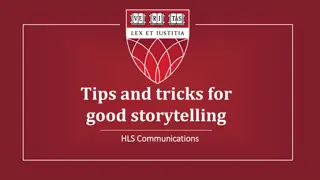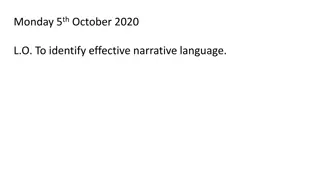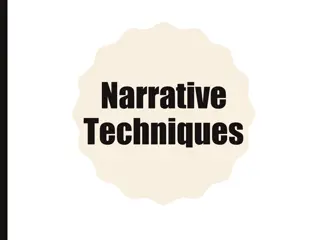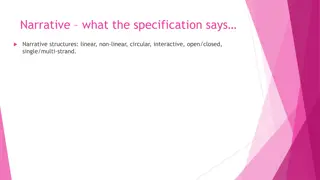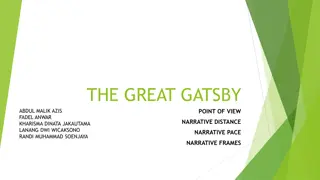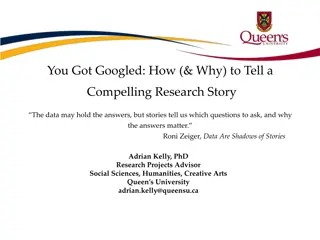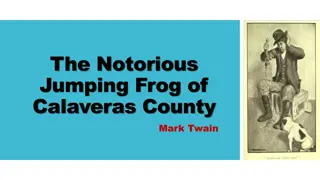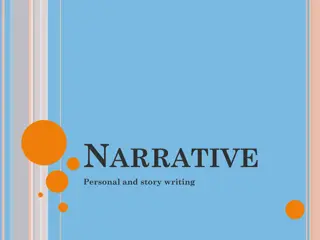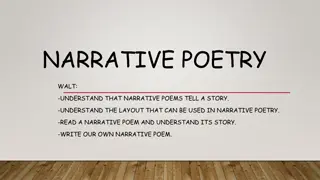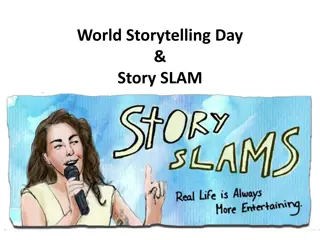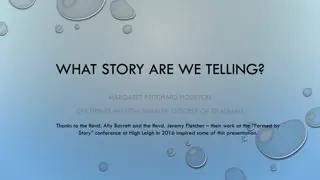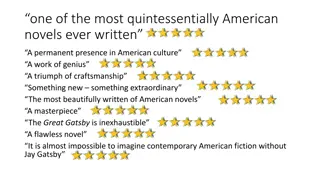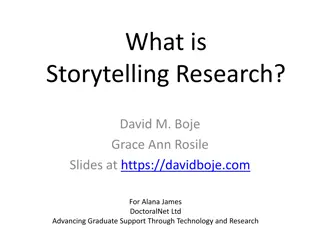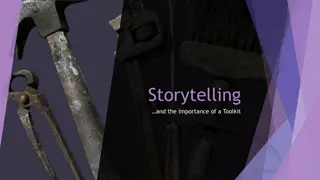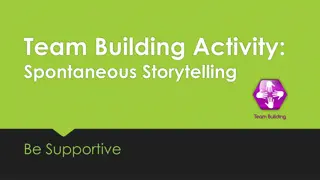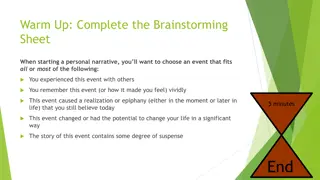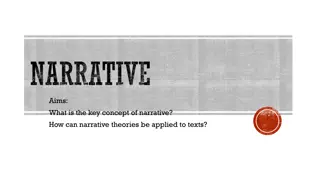Understanding Narrative Techniques for Effective Storytelling
Explore different narrative techniques like first-person perspective, flashback, framed narrative, foreshadowing, and in medias res to enhance your storytelling skills. Learn how these techniques can bring depth and complexity to your narratives, captivating your audience with engaging storytelling structures.
Download Presentation

Please find below an Image/Link to download the presentation.
The content on the website is provided AS IS for your information and personal use only. It may not be sold, licensed, or shared on other websites without obtaining consent from the author. Download presentation by click this link. If you encounter any issues during the download, it is possible that the publisher has removed the file from their server.
E N D
Presentation Transcript
Narrative Techniques Notes
Narrative Bottom line: a specific story about your life Different ways to organize your story
First Person First person narrative is a point of view where the story is narrated by one character at a time. This character may be speaking about him or herself, or sharing events that he or she is experiencing. Uses I, me, we, us, you etc. In first person, we only see the point of view of one character. While this character may share details about others in the story, we are only told what the speaker knows. An author may switch from character to character, but still use first person narrative. This way, we may learn about what other characters think and feel, but we are still limited in our knowledge because we must rely on what the character shares.
Organize Your Story: Flashback Flashback: the author depicts a vivid memory of an event in the past, which have taken place before the present time the narration is following (yet the MAIN story takes place in the present time). Examples: past narratives by characters, depictions and references of dreams and memories Flashback is used to create a background to the present situation, place or person.
Organize Your Story: Framed Narrative Framed Narrative: an introductory narrative is presented, at least in part, for the purpose of setting the stage either for a more emphasized second narrative or for a set of shorter stories. Usually along the lines of Let me tell you a story about The frame story leads readers from a first story into THE MAIN EVENT(S) The frame story may also be used to allow readers to understand a part of the story, then jump to another part that can now be understood.
Organize Your Story: Foreshadowing Foreshadowing is a literary device in which a writer gives an advance hint of what is to come later in the story. Foreshadowing often appears at the beginning of a story or a chapter and helps the reader develop expectations about the coming events in a story. A writer may use dialogues of characters to hint at what may occur in future. Any event or action in the story may throw a hint to the readers about future events or action. Even a title of a work or a chapter title can act as a clue that suggests what is going to happen.
Organize Your Story: In medias res In medias res, ( Latin: in the midst of things ) the practice of beginning a narrative by plunging into a crucial situation that is part of a related chain of events; the situation is an extension of previous events and will be developed in later action. The narrative then goes directly forward, and exposition of earlier events is supplied by https://www.youtube.com/watch?v=8xfmV43DmBs
Organize Your Story: Plot Twist A plot twist is a radical change in the expected direction or outcome of the plot of a narrative. The villain is the hero The witness is the killer It is a common practice in narration used to keep the interest of an audience, usually surprising them with a revelation. Some "twists" are foreshadowed.
Organize Your Story: Breaking the fourth wall Breaking the fourth wall: Breaking the fourth wall is when, throughout the course of a narrative, either the author or the main character talks directly to the reader. For example, the protagonist might do something particularly evil, and then turn around and ask the reader, I know you think I m the worst person in the world right now. But ask yourself: if you were in my position, what would you do differently?
Dialogue Formatting Two (or more) Speakers When two or more people are speaking, each line of dialogue must go to a new line or paragraph. It s a new paragraph because each time a new person speaks, the line must be indented. I ll call you tomorrow, John said. Have a nice day. But I thought you might stay, Diane said. I can t. I have to go. I wish you wouldn t. Mom! I need a drink of water! Diane s daughter yelled from her bedroom.
A Sense of Understanding/Closure Provide a conclusion that follows from and reflects on what is experienced, observed, or resolved over the course of the narrative. Make these colleges pay attention to YOU! (Be unique/avoid clich s) Formulate a memorable/meaningful ending to your narrative Decide after reading your finished narrative if this story serves its intended purpose (admission to college)



